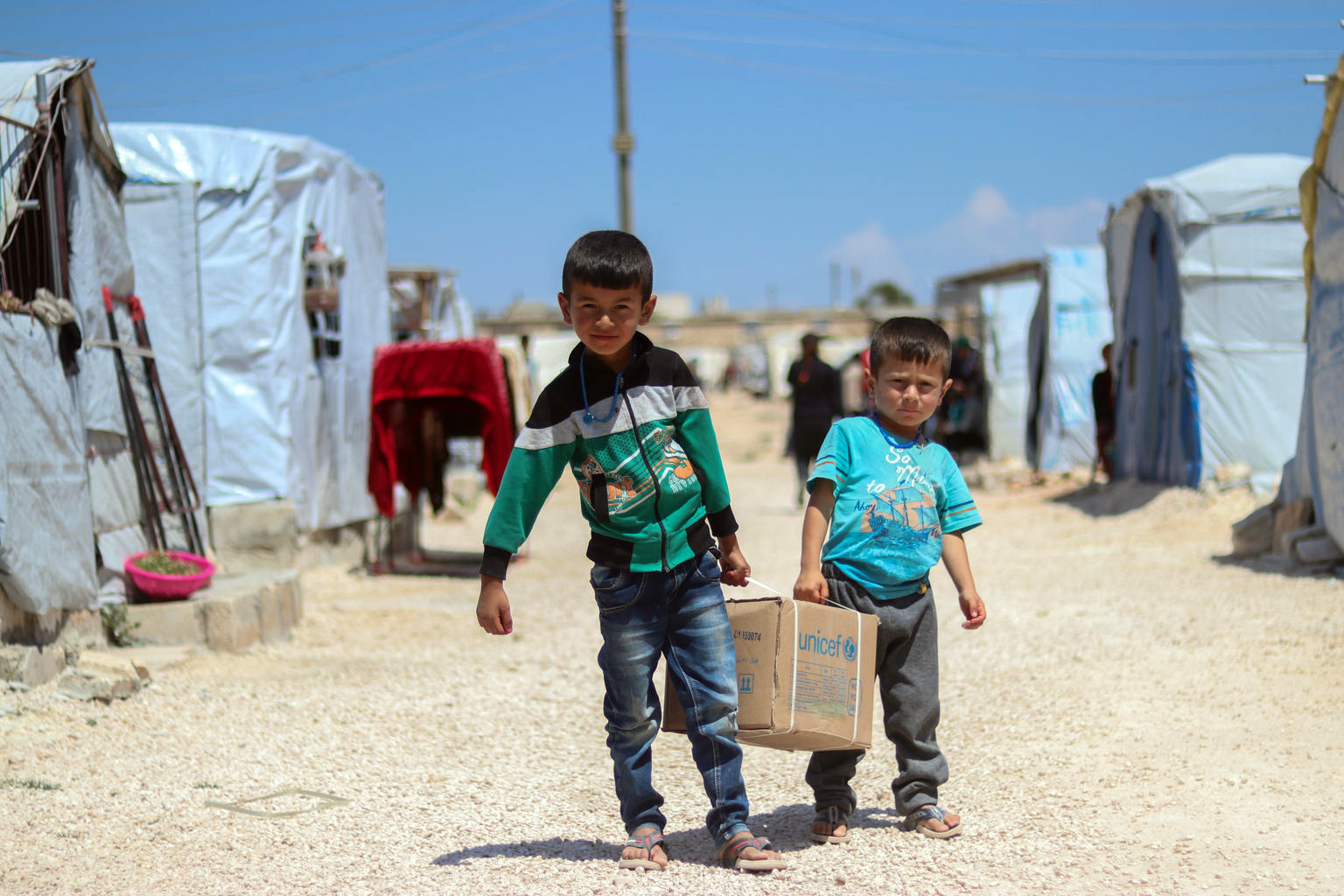War in Syria No breathing space for Syrian children – violence, poverty, child labour and a lack of education pose a danger for millions of children
Two children carry a family hygiene package from UNICEF to their tent in Fafin camp near Aleppo.
Approximately 12,000 children have been killed or injured since the start of the war. Last year, 511 girls and boys lost their lives and 699 were injured. This is merely the verified data. Although the violence has declined, in 2020 the United Nations still documented 61 attacks on schools and 29 attacks on health facilities.
Furthermore, the Syrian conflict has caused one of the worst educational disasters in recent history. Almost 2.5 million children in Syria and 750,000 displaced girls and boys in Syria's neighbouring countries are currently not able to attend school. Right now, six million children inside the country are dependent on humanitarian assistance.
“Syria is the biggest tragedy of this century,” said German Federal Minister Gerd Müller. “After 10 years of war, 22 million people throughout the whole arc of crisis are dependent on humanitarian support. A whole generation of Syrian children has only ever known fear and hardship. The coronavirus is now a further problem. Last year, there was a shortfall of 5.4 billion dollars required to cover the most important support needs in this situation. That is an unbelievable scandal. UNICEF and the World Food Programme have already had to cancel education and protection measures. At the Syria conference at the end of March, all donors must scale up their efforts. And we need a new attempt to find a solution for lasting peace. The response cannot be ”carry on as you are“ for the next ten years.”
“The children in Syria are longing for safety, for schools, and a better future for themselves and for their country. However, suffering and hardship have sadly become a permanent daily reality for them. Even though there has been a decline in the level of violence, there is no sign of a breathing space for the children in Syria,” said Christian Schneider, Executive Director of UNICEF Deutschland. “We are doing everything that we can to strengthen and support children and their families. We are especially striving to make it possible for them to have access to education and learning opportunities, because education is the key to a return to peaceful coexistence.”
Whilst the eyes of the global public have been mainly focused on the efforts to fight the COVID-19 pandemic, the situation for families in Syria has continued to worsen over the past year. Syria's economy is in a nosedive. More and more parents do not know how they will be able to find the means to keep their children fed. The latest figures indicate that an estimated half a million Syrian children are already suffering from chronic malnutrition. In the northwest and northeast of the country, nearly one in every three children is already chronically malnourished. Parents are increasingly finding themselves with no other alternative than to send their children out to work or marry them off young.
The situation is particularly dramatic for the civilian population in the north of Syria. Millions of internally displaced children in the northwest of the country are suffering through the long, harsh winter in tents, emergency shelters and destroyed or unfinished buildings. Three quarters of all the children killed in the last year lost their lives in this region. It is the same region where 93 per cent of the attacks on schools and 73 per cent of the recruitment and battle deployment of minors have occurred. The growing poverty is the reason why many of these children end up joining armed groups, in a desperate attempt to support their families. In the northeast, in Al Hol and in other camps, 22,000 children and youth from an estimated 60 countries are still waiting to be able to travel back to their home countries.
The situation also remains difficult for refugee families who have fled to the neighbouring countries Jordan, Lebanon, Iraq, Turkey and Egypt. Despite their own economic and political challenges, Syria's neighbouring countries are hosting 83 per cent of all the people who have fled from Syria. The COVID-19 pandemic and other challenges have meant that the gross domestic product in Syria's neighbouring countries has fallen by up to 15 per cent. As a result, more and more parents and children are threatened with poverty.
“Despite the incredible challenges they face, Syria's children show us the definition of perseverance and resolve,” said Ted Chaiban, UNICEF Regional Director for the Middle East and North Africa. “Ten years on from the start of the brutal conflict, the children and the people in Syria are still following their dreams. Children are the country's future and an inspiration for us. They continue to need our support, so that they can acquire the necessary skills to rebuild Syria once peace has returned.”
Together with its partners, UNICEF is supporting millions of Syrian girls and boys in Syria, Jordan, Iraq, Lebanon, Turkey and Egypt. These efforts are one of the biggest aid operations in the history of the international children's agency. In 2020, for example, UNICEF was involved in efforts to vaccinate more than 2.6 million children in Syria against polio. Roughly 900,000 girls and boys in Syria and in neighbouring countries have received routine immunisation or have been vaccinated against measles. Altogether, 3.7 million children have been reached with learning programmes and around 400,000 children have received psychosocial support. The BMZ is one of the most important supporters of this work.
This year, UNICEF needs 1.4 billion US dollars in order to support Syrian children in Syria and in its neighbouring countries.
